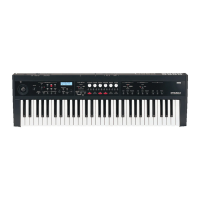Program edit A program’s structure and settings
37
Program edit
You can create original sounds by editing an existing
program to your taste.
A program’s structure and
settings
The PS60’s programs consist of Oscillator settings,
Pitch settings, Filter settings, Amp settings, Effect
settings, and various controllers such as EG and LFO
( “Program structure,” p. 37).
The oscillator section produces the basic sound. It uses
multisamples consisting of multiple PCM waveforms.
There are two oscillators.
The pitch settings modify the oscillator’s pitch, and the
filter settings modify the tonal character. The amp
settings modify the volume.
Controllers such as EG (envelope generator), LFO (low
frequency oscillator), and keyboard tracking can be
used to vary the sound in numerous ways according to
the elapsed time, the keyboard position, and your
performance expressions.
Each program can use one insert effect, you can also
use the master effects (modulation and reverb/ delay)
and EQ to shape the overall sound.
Note: The STRINGS timbre does not have an insert
effect.
Take a look at the illustration below. Notice that the
signal flows in the order of Oscillator/Pitch → Filter →
Amp. The illustration also shows how EG and LFO
affect the sound, and how the signal flows through the
effects.
The three elements of sound
Sound has three basic elements: pitch, tonal character,
and volume. On the PS60, these elements are
controlled by the “pitch,” “filter,” and “amp
(amplifier)” sections respectively.
Major program editing
functions
Editing the pitch
You can edit the way in which the oscillator’s pitch will
change. The pitch will vary over time according to the
Pitch EG and LFO settings.
• Use an EG to control the pitch.
“Attack (Pitch EG Attack Time)” – “Release (Pitch
EG Release Time)” (p. 42)
• Use the LFO to apply vibrato.
The depth of the effect produced by pitch LFO1 is
specified by “LFO1 Int (Pitch LFO1 Intensity)”
(p. 42).
The speed of the effect is specified by “LFO”
(p. 42).
• Apply portamento.
“Portamento (Portamento Enable)” – “PortaTime
(Portamento Time)” (p. 43)
• Use the keyboard position to vary the pitch.
“PtchSlope (Pitch Slope)” (p. 43)
This makes the pitch rise as you play toward the
right of the keyboard, as on keyboard instruments
such as piano and organ.
• Specify the amount of pitch change that will occur
when you move the joystick to left or right.
“Pitch JS+X,” “Pitch JS–X” (p. 43)
AUDIO OUTPUT
L/MONO, R
MODULATION
Insert FX
EQ
REVERB/DELAY
SEND1
Chain
On/O
Return1Return2
SEND2
OSC1 Basic
Amp1
Pitch EG
Filter1 EG
Amp1 EG
OSC1 LFO1
OSC 1
OSC 2
Filter1 Mod
Filter1 LFO Mod
OSC1 Pitch
OSC1 LFO2
Amp1 Mod
Filter1(A/B)
Common LFO
Audition Ri
Program structure
*The STRINGS
program does
not have an
insert effect.
Oscillator / Pitch Filter Amplifier Effects

